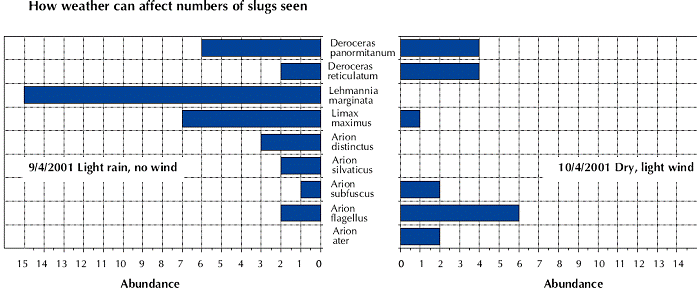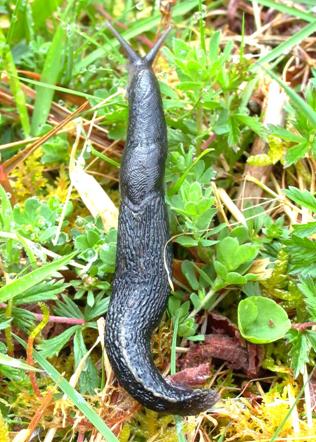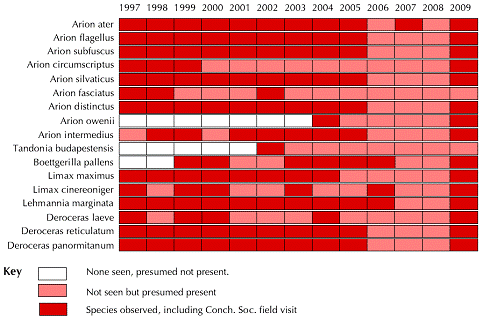My Skye slug recording began in 1997 when we had booked a family holiday in Skye over Easter. The proprietors of the guest house we had chosen, Pat and Roger Cottis, had advertised themselves as member of various natural history societies. That seemed to be good enough for us. When we arrived, I asked if they would mind if I brought in a slug, which I had found on the way, for close examination in good light. Absolutely no problem - Roger immediately cleared a worktop in the lounge and asked if he could have a close look too. Later Pat came in with a 'little friend' she had found in the rhubarb she had cut. A first for Skye - Deroceras panormitanum which we now refer to as the “rhubarb slug”. Our holiday was very productive on the slug recording front and we have returned most Easters since then to visit Pat and Roger who are now firm friends and suppliers of occasional slug records.
Figure 1. Slug abundance on two successive nights with different weather conditions
 The first thing discovered was that Skye is under-recorded as far as slugs are concerned. No surprise here, but it is always very rewarding to find new records. Our first visit gave a good number of new species records for Skye. Some of these resulted from the existence of 'new' species, for example Arion distinctus and Arion flagellus. Others, such as our rhubarb slug, resulted from fairly recent colonisation. As years went by, we continued to look in new places but also to revisit some old haunts.
The first thing discovered was that Skye is under-recorded as far as slugs are concerned. No surprise here, but it is always very rewarding to find new records. Our first visit gave a good number of new species records for Skye. Some of these resulted from the existence of 'new' species, for example Arion distinctus and Arion flagellus. Others, such as our rhubarb slug, resulted from fairly recent colonisation. As years went by, we continued to look in new places but also to revisit some old haunts.
Because of the all-pervading power of Murphy's Law, it is usually difficult to find slugs on occasions when you set out to do so deliberately. I usually note some measure of slug abundance and habitat with my records. This has proved useful in helping direct searches to places and times where and when slugs will be easiest to find. Conclusions are sometimes as might be expected, but not always. For example, on two successive nights I went on a slug hunt in exactly the same place, on the same route, for the same length of time - how boring slug watchers can become. The only difference in the events was in the weather conditions. The results are most instructive (see Figure 1).
So to enjoy after-dark slug watching, make sure the weather is damp and calm. What about habitats? Assessing all of my records for the two habitats searched most - woodland and 'human influenced' - the diversity of species was similar and the total number of records was also the same. What I have not recorded is time spent in gathering records. And here, I think there is a difference. Woodland, even pristine, natural woodland may have a diverse slug
fauna but slugs are not generally massively abundant. On the other hand human habitats, including compost heaps and
brownfield sites, often have both diversity of species and abundance. We have one deeply ingrained memory of a morning spent searching in a natural, ancient coastal woodland at Ord, almost untrodden by human foot. Unfortunately it was also almost untrodden by slug foot, with a total of only six species, all of which are commonly found elsewhere in the island and all of which were hard to find in the woodland. In the afternoon we made a much shorter visit to an unpromising, abandoned industrial site in Broadford. Slightly greater species richness but vastly more abundance awaited us with seven species found including Boettgerilla pallens. All these species records gained with little expense in time or effort. (Of course, the danger of knowing that slug hunting is better in damp weather and that brownfield sites are good hunting grounds is that these become self-fulfilling prophecies and other habitats and conditions are overlooked.)
Our records are all submitted to the national recording scheme and also the 'local' group - the Highland Biological Recording Group (HBRG) (see also page 30). Its area is somewhat larger than a typical Watsonian vice-county. In the HBRG newsletter, there had been some correspondence about the value of what was called 'local patch recording'. This is where people record species or natural events, over a long period of time, in some small area. It was very pertinent to the slug hunting in Skye, even though I am just a 'foreign' member of the group and my patch consists of various short annual visits to a rather large island. The value of local patch recording lies in being able to document changes rather than just static species distributions. Missing species can be just as important as those present. Of course, local patch recording is absolutely pointless unless information is accessible - and that means some form of computerisation (even if just as word-processed notes). As I had found back at home with the slug recording group I had run at school, slug distributions are changing. It is definitely worth revisiting sites from time to time. Provided you have searched thoroughly in the past, you can be fairly confident new species are new species rather than long-standing residents that you have overlooked previously. Figure 2 shows species recorded over the years. The 2009 records include those from the Conch. Soc. field visit (which, through another application of Murphy's Law, neither Roger or I were able to attend).
 Some species have been particularly interesting to observe. Arion flagellus can be found almost anywhere, often in association with Arion subfuscus and Arion ater. Like Arion ater it will appear in daylight when conditions are damp enough without being too wet. Arion owenii appears to be a newcomer. We did not record it until 2005 when it was found in a Portree car park, just above the shore line. We did not visit again until 2009. It was found then in two more places - a small, abandoned quarry near the Armadale ferry terminal and in a car park at a visitor centre near Portree. The Conch. Soc. visit found it in Armadale and also in Broadford. All of these were places which had been searched in previous years. These findings were all in places much visited by humans and their vehicles. Unlike Arion flagellus, it appears that Arion owenii is a genuine recent arrival on the island. Arion fasciatus had been recorded both in the far north and far south of Skye. It is not common and seems to be associated with human habitation.
Some species have been particularly interesting to observe. Arion flagellus can be found almost anywhere, often in association with Arion subfuscus and Arion ater. Like Arion ater it will appear in daylight when conditions are damp enough without being too wet. Arion owenii appears to be a newcomer. We did not record it until 2005 when it was found in a Portree car park, just above the shore line. We did not visit again until 2009. It was found then in two more places - a small, abandoned quarry near the Armadale ferry terminal and in a car park at a visitor centre near Portree. The Conch. Soc. visit found it in Armadale and also in Broadford. All of these were places which had been searched in previous years. These findings were all in places much visited by humans and their vehicles. Unlike Arion flagellus, it appears that Arion owenii is a genuine recent arrival on the island. Arion fasciatus had been recorded both in the far north and far south of Skye. It is not common and seems to be associated with human habitation.
Boettgerilla pallens is also a new arrival. We first found it on Eilean Ban in 1999 - the island which supports the Skye Bridge. It was adjacent to the wall separating the island from the roadway. The following year it was in exactly the same place (but unlikely to be the same individual). In 2003 we found it elsewhere - both in places searched before and in new places - and records continue to accumulate. Clearly a new arrival, it seems likely one brought in by road transport. Tandonia budapestensis has been, thankfully, only seen once in 2002. Although in woodland, it was on the very edge adjacent to a garden. It was in a place previously searched. It seems likely that it appeared in connection with gardening operations and was spreading away from the point of infestation. It could well become established - as it has become so elsewhere in Scotland in association with human settlements. There are no historic records for any of the keeled slugs on the island except one for Milax gagates in some gardens in Sleat. We have looked here but not found any.
Limax cinereoniger is present and widespread but not abundant. (See below, at Kinloch (photo: author)) Some records are, naturally, in ancient woodland or plantations where ancient woodland had stood previously. However, we also have seen it in two different years in an apparently unlikely place - Eilean Banh. This island cannot, by any stretch of the imagination, be said to be either well wooded or undisturbed. One specimen was found next to the Maxwell cottage, lurking under a piece of damp chipboard left during building works. Deroceras panormitanum, as expected for a newcomer, is generally associated with human activity. The few observations in other habitats have all been very close to these 'human' habitats.
Of interest, too, are slugs that have not yet been seen. Limacus flavus has been recorded on the mainland near to the island.[*see note below. Ed.] I suspect it is present on the island. It is generally under-recorded in spite of its tendency to live in close proximity to (or even inside) human habitation. It is highly nocturnal and so rarely seen - although its trails through the kitchen may often be seen and remarked on the next morning. Lehmannia valentiana is another good candidate for appearance. With its appearance in some many parts of Britain, it seems unlikely that it has not arrived in Skye. The question is not so much whether it has arrived but whether there are any viable populations. The climate in lowland Skye is not particularly severe and, if the species arrives, it should be able to thrive in sheltered gardens. A compost bin census would be the answer - that would probably find Limacus flavus too. Perhaps in 2010?
* Note from Adrian Sumner: “In recent years I've only found L. maculatus in Scotland, whereas L. flavus was certainly present some years ago, so it looks as if maculatus is replacing flavus.”
Figure 2: Slug species observed on Skye by year.

